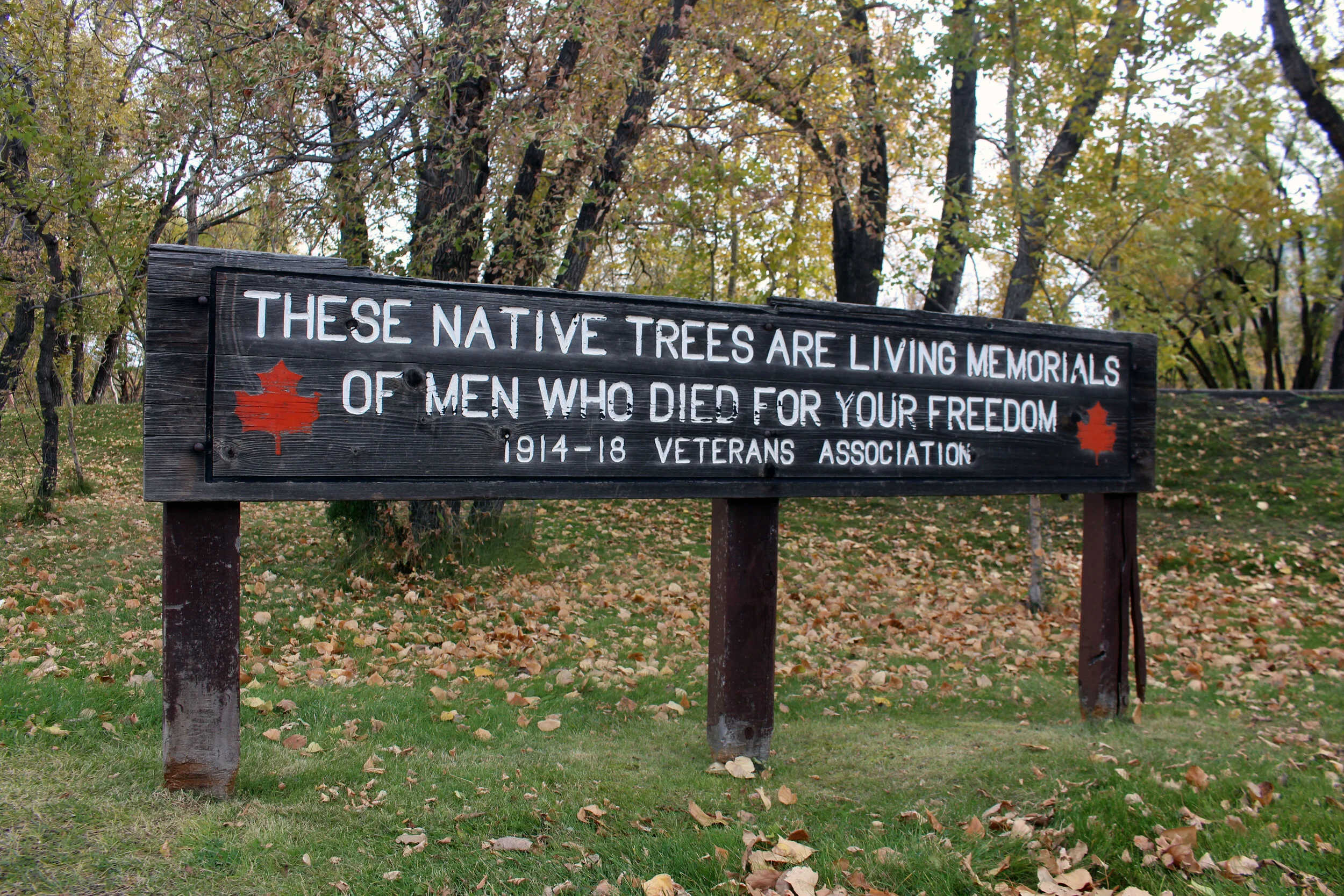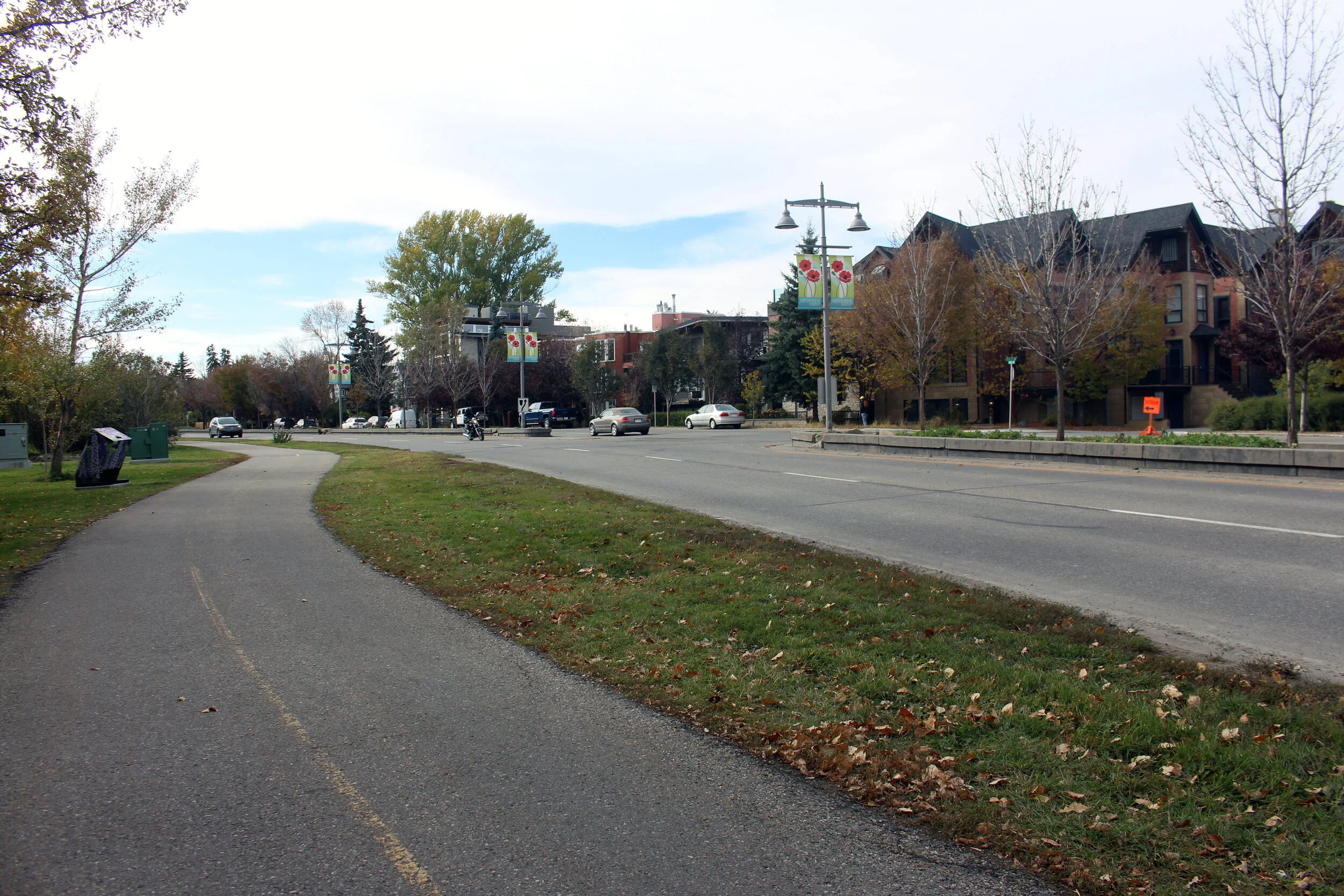Words and photos (where uncredited) by Lisa Chong
The November 2019 cover photo (above) features Hillhurst Sunnyside community members in front of the beautiful heritage tree at Poppy Plaza on the corner of 10th Street NW and Memorial Drive NW. As a place of reflection, this heritage green ash tree represents the historic living memorial which starts on the west side of 10th Street and expands east to the St. George’s Island zoo bridge.
As a coordinated effort to memorialize the fallen soldiers of World War I in the 1920s, the City of Calgary and other stakeholder groups started their monumental task to plant one tree for every fallen soldier of the Great War. Most of these trees in the living legacy project were poplar trees, which were believed to be wild trees brought to Calgary from miners returning from Drumheller.
“On May 11, 1922, the first tree was planted on Sunnyside Boulevard (now Memorial Drive), between ninth and nine-and-a-half St. N.W. by Mayor Adams.”
– City of Calgary Parks History
3,278 trees were planted between 1922 and 1928. These trees originally bore commemorative plaques; soldiers’ next-of-kin were involved in the purchasing and the planting of the trees for $1 each. While the original poplar trees have reached the end of their lifecycles, the offspring of these trees live on. The City, in 2001 selected cuttings from the remaining trees to ensure that the living memorial will continue in perpetuity. Today, 1,500 cloned poplars grow in Grand Forks, B.C. – and on June 22, 2007, a ceremony was held to mark the arrival of three cloned trees, which were planted in the same approximate location as the originals.
Landscape of Memory and Poppy Plaza
Poppy Plaza was a part of the $30 million Landscape of Memory project which spans the north side of the Bow River between Shaganappi Trail to the west and St George’s Island (zoo bridge) to the east. The entire project was funded by the (now-defunct) Enmax Legacy Parks program, while Poppy Plaza had an estimated cost of ~$11 million. The entire project was completed between 2010-2014.
Poppy Plaza was designed by Marc Boutin Architectural Collaborative (MBAC) and Stantec, guided by the City and informed by stakeholder input on the design principles of: Continuity, Accessibility, Legibility and Legacy. When asked about the heritage tree and plantings, Marc Boutin says:
“When we were commissioned to design the plaza, we planted a new bosque of trees within the plaza and re-commemorated the original tree as an important nod to the original gesture by the city, a gesture that gave us the trees along Memorial Drive. If you visit the plaza, there is some dedication language on the ground-plane that explains this commemoration.”
Along with native grass and shrub plantings on the pathway, aspen trees now adorn the plaza.
The regional Landscape of Memory project was completed in phases between 2011-2013, spanning multiple North Bow river communities: Point McKay, Parkdale, West Hillhurst, Hillhurst-Sunnyside, Crescent Heights and Bridgeland-Riverside, memorializing history and creating meaningful public access to the river.
Conversations around the planning decisions that created urban freeways in the 1960s have become more relevant at a time when major North American cities are facing the prospect of replacing aging urban infrastructure and reconnecting and vitalizing the walkable, human-scale, historic city centres that developed close to the waterfront.
At one time, Memorial Drive was slated to become an urban freeway in the 1970s; this road widening project was opposed by the community and HSCA and the plans were eventually eliminated. Memorial Drive was designated as the first and only parkway in Calgary, valued for its views of the river and the downtown core, the adjacent Bow River Pathway and as a Road of Remembrance.
Points of Interest this November
Commemorative Plaque on the east side of 10th Street, placed on September 9, 1990 to rededicate the Memorial Drive trees and to honour those who served WW1, WW2, the Korean War and in Peacekeeping Missions.
Calgary Soldiers Memorial west of Poppy Plaza, designed by MBAC in collaboration with Mewata Armouries. This public monument honours each of the Calgary fallen throughout our history with global conflicts from the Boer War to present day.
Field of Crosses at Sunnyside Bank Park between the Curling Club and Centre Street. From their website: “over 3,600 crosses are placed along Calgary’s Memorial Drive from November 1-11 each year. Each cross memorializes an individual soldier from Southern Alberta who made the ultimate sacrifice during active duty protecting our country.”
Kensington Legion Remembrance Day Ceremony. To participate or volunteer for the November 11th ceremony at our local Legion No.264 branch, visit www.kensingtonlegion.ca for details.
Victory Homes in nearby West Hillhurst. The modest “strawberry box” style houses were built for returning soldiers after 1945. Originally designed to last 5 years, many of these homes still stand today.
Photo collage (from left to right, top to bottom): Memorial Drive re-dedication plaque, Soldiers Memorial, West Hillhurst Victory Homes, Kensington Legion building, Field of Crosses
The Memorial Drive trees from 10th Street NW to the zoo bridge were evaluated by the Calgary Heritage Authority and recognized on the City of Calgary’s Inventory of Historic Resources. The sources cited for this article are included below for further reading.
Resources
City of Calgary | Discover Historic Resources - Memorial Drive: https://www.calgary.ca/CSPS/Parks/Pages/Locations/NW-parks/Poppy-Plaza.aspx
City of Calgary | Memorial Drive Landscape of Memory: https://www.calgary.ca/CSPS/Parks/Pages/Construction/Memorial-Drive-Landscape-of-Memory.aspx
City of Calgary | Memorial Drive trees: https://www.calgary.ca/CSPS/Parks/Pages/History/Memorial-Drive-trees.aspx
City of Calgary | Poppy Plaza: https://www.calgary.ca/CSPS/Parks/Pages/Locations/NW-parks/Poppy-Plaza.aspx
Enmax Parks Legacy Program - Memorial Drive: https://www.calgary.ca/CSPS/Parks/Documents/Construction/Enmax-Parks-Program/memorial-drive.pdf
Field of Crosses Memorial: https://www.fieldofcrosses.com
Glenbow Museum Photographs Archives | http://ww2.glenbow.org/search/archivesPhotosSearch.aspx | Search: Memorial Drive & West Hillhurst
The Marc Boutin Architectural Collaborative: http://www.the-mbac.ca/#/portfolio/public-realm/memorial-drive-landscape-of-memory-poppy-plaza and http://www.the-mbac.ca/#/portfolio/public-realm/calgary-soldiers-memorial
Margaret Tanko | Hillhurst Sunnyside Remembers (HSCA; 1978)
People: Bill Latimer, Pat Mahaffey (residents), Marc Boutin (Principal, MBAC), Michelle Reid (Cultural Landscape Lead, City of Calgary Parks)
Federation of Calgary Communities | West Hillhurst Community Association Profile: https://calgarycommunities.com/communities/west-hillhurst-community-association






